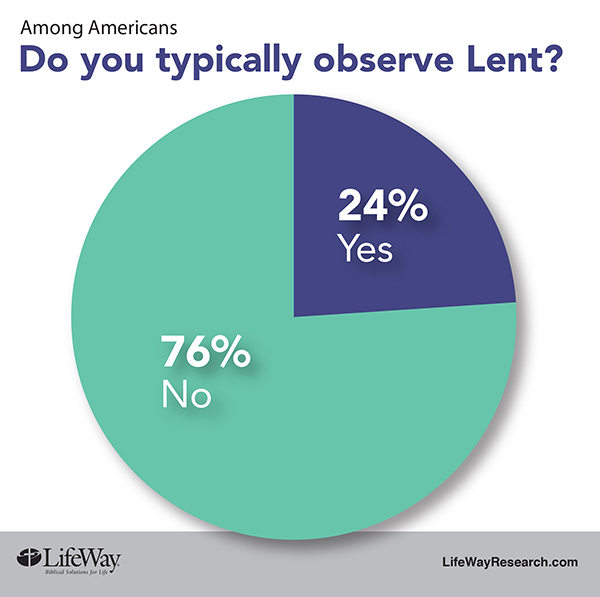During the season of Lent, some Americans give up chocolate or another favorite food. Others dump guilty pleasures like binge-watching television or social media.
But most give up Lent.
Three-quarters of Americans (76 percent) say they don’t typically observe Lent, according to a survey from Nashville-based LifeWay Research released Feb. 15.
Unlike other Christian traditions like celebrating Easter or Christmas, Lent seems to lack crossover appeal, said Scott McConnell, executive director of LifeWay Research. It remains a religious event, he said, rather than one that appeals to a broader public.
That’s in part, McConnell suspects, because Lent focuses on giving things up in order to gain spiritual benefits in preparation for Easter. There’s no social benefit to Lent like giving gifts or getting together with family.
It’s a religious tradition that remains focused on personal devotion, McConnell said. “Lent is not about having your best life now,” he said. “Those who observe it believe they are giving up things they want in order to focus on what God wants. There’s little popular appeal in that.”
Lent, which begins Ash Wednesday (March 1) and ends during Holy Week, is traditionally seen as a time of preparation for Easter. Part of that preparation for some includes various forms of fasting as a spiritual discipline — a practice that dates back to the early Church. Lent traditionally lasts for 40 days (excluding Sundays), a time frame established after the Council of Nicea in 325 A.D.
Catholics (61 percent) remain most likely to observe Lent, according to the survey. Protestants (20 percent) and those with evangelical beliefs (28 percent) are less likely.
Attending services
Forty-three percent of those who attend church at least once a month observe Lent. That includes 82 percent of Catholics who regularly attend service as well as 30 percent of Protestants.
Older Americans, those over 55, are more likely to observe Lent (30 percent) than those under 55 (20 percent). Hispanic Americans (36 percent) and Christians in general (35 percent) also are more likely to observe Lent. Those from non-Christian faiths (12 percent), “nones” with no denominational affiliation (4 percent) and those who attend services less than once a month (15 percent) are less likely.
McConnell said the degree of popularity of Lent among those with evangelical beliefs is surprising. Lent is often associated with Catholics and Mainline Protestants from more liturgical denominations.
But it holds appeal for evangelicals as well, he said.
For one pastor, however, Lent stirs reticence.
Rob Pochek, pastor of First Baptist Church, Park Street, in Charlottesville, Virginia, wrote in a 2015 blog, “It seems to me that any attempt I may make [to observe Lent] does not memorialize the death of Christ as much as it trivializes it.”
Pochek — who respectfully noted his mother’s side of the family is Catholic, including three great-aunts who are nuns and a great-uncle who is a priest — wrote, “In one sense, the death of Christ was the most horrific thing in all of human history. … At the same time it was the most glorious of all deaths. In the death of Jesus, God reconciled the world to Himself.”
Fasting from a favorite food or beverage (57 percent) and going to church (57 percent) are the most common ways to observe Lent. Additional prayer (39 percent), giving to others (38 percent) or fasting from a bad habit (35 percent) also are popular.
Fasting from a favorite activity is less common (23 percent).
Fasting from a favorite food or beverage is more common in the West (62 percent) than the Northeast (42 percent). Young Americans, those 18 to 24, who observe Lent are more likely to choose this option (86 percent) than those over 65 (43 percent). Catholics (64 percent) are more likely give up a food or drink than Protestants (43 percent).
‘Giving things up’
Those with evangelical beliefs (71 percent) are more likely to go to church during Lent than those without evangelical beliefs (54 percent).
Those who attend church at least once a month go to church more during Lent (76 percent) than those who don’t (32 percent).
“There’s a lot more to Lent than giving things up,” McConnell said. “Americans who observe Lent also take other steps — like praying, giving and going to church more — to practice their faith.” (BP)






Share with others: